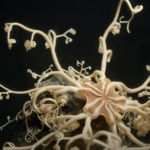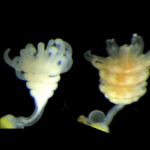
What do hyperbolic crochet and coral reef organisms have in common? They both evolved to maximize surface area within a limited volume. So, naturally, a crafty and talented group of mathematicians at the Institute for Figuring who are concerned about the effects of global warming would want to knit a Hyperbolic Crochet Coral Reef for the Chicago Cultural Center.
Go there to see crocheted sea slugs and cephalopods, a hyperbolic brain coral, and other fantastic things, like a plastic reef, and a lesson in hyperbolic crochet taxonomy.
Hyperbolic crochet is an unexpected outgrowth of hyperbolic geometry developed ten years ago by Dr. Daina Taimina of Cornell University. The technique produces beautiful textiles that also serve as models for hyperbolic planes and their accompaniments like “ideal triangles”, whose angles sum to zero, and “pseudospheres”, a form which is the hyperbolic equivalent of a cone.
 Here’s the tie-in to coral reefs. High surface area to volume ratios in benthic suspension feeders (like coral) yield more feeding space for polyps and their photosynthetic xoozanthellae. Hyperbolic forms can also be seen in the crenulate margins of the nudibranch or the kelp frond. Increased surface area in pelagic phytoplankton serves several functions- to facilitate greater nutrient absorption, for instance, or to decrease sinking rate, which permits increased exposure to sunlit waters.
Here’s the tie-in to coral reefs. High surface area to volume ratios in benthic suspension feeders (like coral) yield more feeding space for polyps and their photosynthetic xoozanthellae. Hyperbolic forms can also be seen in the crenulate margins of the nudibranch or the kelp frond. Increased surface area in pelagic phytoplankton serves several functions- to facilitate greater nutrient absorption, for instance, or to decrease sinking rate, which permits increased exposure to sunlit waters.
Thanks to Barn Owl for the crochet tip(s). This is great stuff. Those sea slugs and pseudospheres sure would make nice Christmas presents…
Top: “Crochet Coral and Anemone Garden” with sea slug by Marianne Midelburg.
Photos by Alyssa Gorelick.






That is utterly amazing and wonderful! I would SO like to learn to do that crochet! Are there any patterns? Yes, I’m quite serious.
If you follow the link to the Hyperbolic Crochet Coral Reef you’ll find a link under “How to do hyperbolic crochet”. I don’t see any patterns, though, unfortunately.
I adapted the basic hyperbolic plane crochet method to make nudibranchs with crenulate margins. First, crochet a chain of 15-20, using a stiff, inexpensive acrylic yarn; instead of turning back at the end of the first single crochet row, keep going around the other side of the foundation chain. 3 or 4 rounds (they can be hyperbolic, with increases every 8-12 stitches) with the acrylic yarn makes a good nudibranch body. End the acrylic yarn, and switch to a soft novelty yarn for the crenulate margin. I usually single crochet 5-8 hyperbolic rows for the margin, with increases every 6 to 8 stitches.
Add beads, and crocheted chain rhinophores and gills, and you have a nudibranch. Nudibranchs crocheted with baby yarn (and no beads, of course) make great gifts for babies. Click my screen name to go to my crafts blog (which I neglect horribly) to see photos of nudibranchs, a sea lemon, and an Aplysia I’ve crocheted.